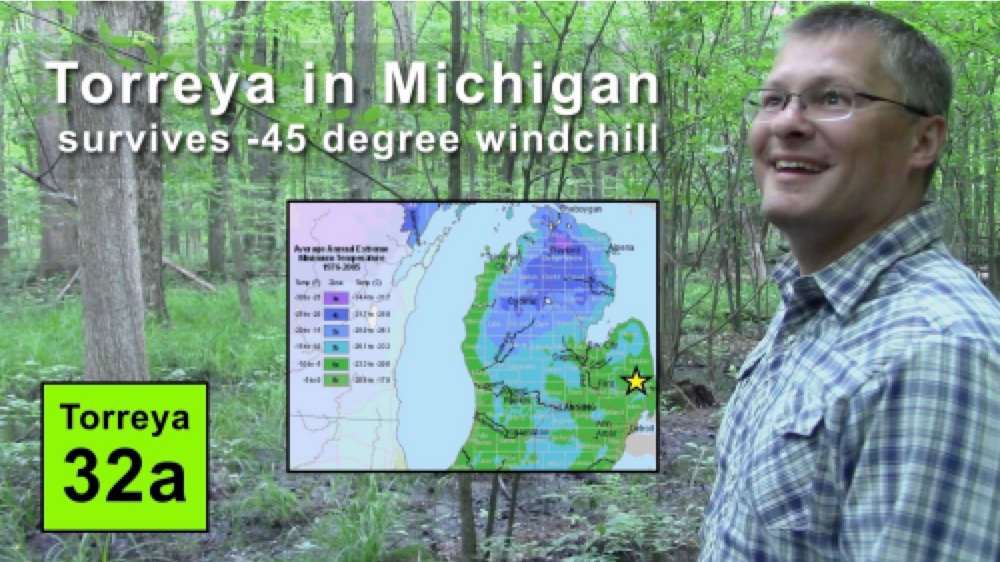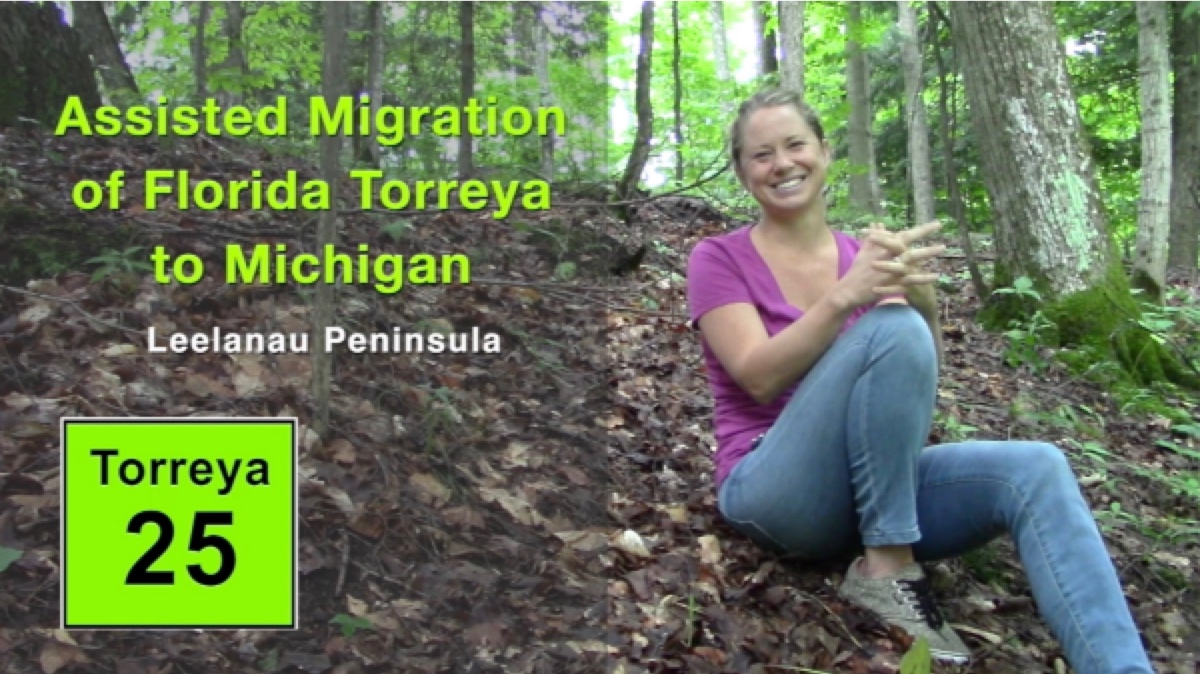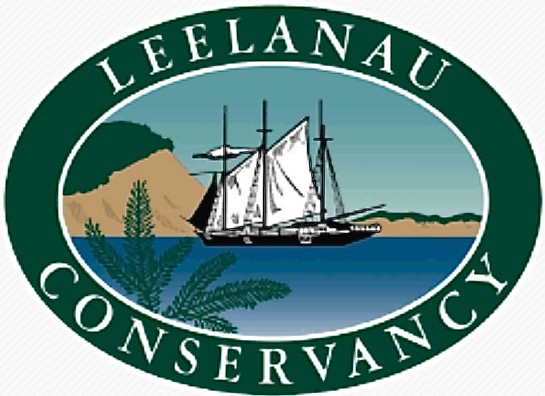BACKGROUND: At least since the last glaciation of the Pleistocene, the two U.S. species of genus Torreya have been found only in California and along the Apalachicola River of the Florida panhandle. Nonetheless it is postulated that the Apalachicola species of Torreya (T. taxifolia) would have been native to the southern Appalachians and possibly further north during previous interglacials and warm epochs of the Cenozoic.
 |
| |
Torreya Guardians began moving Torreya taxifolia into regrowth forests on private land in NORTH CAROLINA in 2008. Soon thereafter, the effort expanded into field tests in OHIO. In 2014, seeds were planted in two regrowth forests in MICHIGAN — but apparently at too shallow a depth to remain undetected by rodents. In later years, all seeds were either germinated in pots first or directly planted at least 4 inches deep.
LEFT: As of JANUARY 2025, 5 outdoor sites in Michigan have become viable experiments. A well-established within-forest planting of more than a dozen specimens in the "thumb" of Michigan is the YELLOW STAR. The tallest torreyas are a pair of trees upwards of 5 feet tall at the home near Grand Rapids (ORANGE STAR).
The aim is to ascertain just how far north Torreya can survive (possibly thrive) in today's climate, in expectation that conditions will continue to warm in the decades ahead. There is value in establishing "left-behind" tree species as far north as possible to ensure viability later in this century.
Given that our torreya planter in Cleveland OHIO has been producing seeds every year since 2018, we Michiganders can feel pretty optimistic about our prospects — so long as we provide individual cages or fencing to fend off hungry deer. |
Note how the map above shows the Great Lakes creating a diverse patterning of "plant zones" for testing Torreya in the state of Michigan (USDA 2012). Green zones are the warmest places.
Successful Plantings in Michigan
• CAPAC ("thumb" of Mich.)
 |
 |
In April 2017, Torreya Guardians sent Paul Camire 200 Florida Torreya seeds from the autumn 2016 Medford OR ex situ harvest. Paul has "a 45-acre forest, and with the loss of the ash trees to the emerald ash borer I am looking to replant with conifers. The woods has white oak, beech, linden, red oak, swamp white oak, witch hazel, etc." Paul has also been experimenting with Florida Yew, Giant Sequoia, Franklinia, and American Chestnut.
July 2018 Paul reported the first tiny seedlings: just three at that time. By Sept 2018 a total of 9 had germinated. Crucially, he planted all of them 4-6 inches deep, which seems to be the key to success. See VIDEOS, PHOTOS, and ongoing DOCUMENTATION at Capac MI torreya webapge.
PHOTO ABOVE LEFT: A 2-part video of Paul Camire's torreya plantings, was filmed by Connie Barlow June 2019. Summer 2023 was when a comparison video was filmed and posted.
PHOTO ABOVE RIGHT: Paul also planted potted seedlings from several sources to encourage genetic diversity at his site. His tallest torreyas thus come from the potted seedlings.
• Visit the CAPAC, MI torreya page
• LAKE MICHIGAN SHORE
 |
| |
There are 3 locations near the shore of Lake Michigan:
1. MUSKEGON (Montague) - Peter Bane and Keith Johnson are permaculturalists who received from Connie Barlow 40 seeds in September 2014, from the 2013 harvest. All were germinated in a greenhouse, and the survivors outplanted. As of July 2022, 3 were still alive (heavily browsed by herbivores) in nearly full-sun settings. (PINK STAR)
2. LUDINGTON (Fountain) - Julia Chambers lives in a forested rural landscape, with a great many deer. Her immediate area is mostly forest, with several small lakes nearby. To the west is mostly farm fields, with some woodlots. To the east is national forest. She received and planted one newly germinated seedling from Connie Barlow in July 2015. The one seedling is still alive 7 years later, July 2022. (DARK PINK STAR)
• Visit the combined MUSKEGON and LUDINGTON page
3. GRAND RAPIDS - January 2025 John Czerney, an established torreya tree planter, discovered Torreya Guardians via our videos on youtube. We were delighted to immediately post a new webpage for his project, as his two torreyas are more than 5 feet tall! (ORANGE STAR). See the section directly below for a photo.
|
• GRAND RAPIDS
 |
|
John Czerney lives near Marne, Michigan. It is northwest of the city limits of Grand Rapids. He has 2 specimens of Florida torreya. He affiliated with Torreya Guardians in 2025, when the PHOTO at left was taken.
The Torreya taxifolia at left is 54 inches tall. It is growing in a fern bed in John's backyard. Situated north of a hemlock tree and a Norway spruce, this torreya accesses enough sun to grow in a Christmas-tree-like pattern. It is also "close enough to the house to reach with a garden hose during severe droughts."
The other specimen was planted to the side of his house and is rarely if ever watered. It is under an oak and near the arborvitaes. It gets morning sun, but shade for the rest of the day. Even so, it is "somewhat taller and fuller-looking."
The prevalence of deer in the lower half of Michigan compelled John to install fencing around each torreya.
Despite Michigan's cold winters, John has never observed any cold-weather damage on this pair.
Very significantly, he experimented with the California torreya and with the southern-most of the 3 Asian species: Torreya grandis. Both of those did poorly.
• Visit the GRAND RAPIDS page
|
• YPSILANTI
Connie Barlow founded Torreya Guardians in 2005, while she and her husband (Michael Dowd) lived on the road. Consequently, she had no homesite in which to plant, tend, and monitor Torreyas.
September 2020 Barlow and Dowd's itinerant lifestyle came to an end. They settled in Connie's home state, and rented an apartment two blocks from their new grand-daughter in Ypsilanti. Renters have no property. Worse, overpopulated deer destroyed edible horticultural plantings in the area (indeed, almost everywhere in Michigan). The only deer-free zone was in the densely populated downtown area, where Connie lived. There she saw an unusual opportunity.
 |
| |
In 2021 and 2022 Connie began planting Torreya seeds into patches of deep soil on the steep forested slopes of the Huron River, where it passed through downtown. Strewn with old industrial debris and discarded chunks of concrete and asphalt, these slopes had nonetheless acquired some native deciduous trees, even while the subcanopy was missing — or dominated by the exotic invasive Amur Honeysuckle.
Here was an opportunity for guerrilla rewilding: planting seeds into a forlorn public landscape.
• Visit the YPSILANTI page
|
• ANN ARBOR
 |
|
Bill Brodovich (a professional ecologist and conifer specialist) became a new Torreya Guardian in autumn of 2024. Connie Barlow gave him 21 seeds from the pot of 238 seeds she was keeping for a second winter of stratification of seeds from Fred Bess's 2023 harvest of seeds in Cleveland, Ohio. 19 November 2024 Bill wrote:
I planted the Torreya seeds on November 4. I planted one seed in each of 21 one-gallon containers, and then buried the containers in the ground in my yard. Each container has a numbered tag.
As an experiment, I added 1 cup of lime (calcium carbonate) to 2 containers, half a cup to two containers, and a quarter cup to 2 containers. Since the species is native to limestone bluffs, so I thought it would be interesting to see if the additional calcium affects their growth.
I buried two of the seeds 2 inches deep, and all the rest 4 inches deep. I then covered the containers with fencing to keep the squirrels out. Now I have to wait out the winter — that is, if we get a winter. I can�t believe how mild this fall has been. Some trees in my neighborhood are still hanging on to their brilliant leaves.
• Visit the ANN ARBOR page
|
Unsuccessful Plantings in Michigan
Editor's note: Any seeds planted prior to 2017 would have been shallow planted, which we later learned was a guarantee of seed-predation by rodents. As in science, "negative results" are crucial to report, so these 100% losses are among the examples listed below.
ALPENA, MI: In spring of 2014 Halsey Barlow planted 40 seeds on the property of her parents (Bill and Peggy Barlow) along the Lake Huron shore (barely zone 5b). Provenance of seeds: 4 from 2012 harvest, 34 from 2013 harvest, 2 from Mt Olive NC tree 2013, 2 from Clinton NC tree 2013, 2 (underripe/sticky) from Spencer NC. OUTCOME: No seedlings visible in subsequent years.
LUDINGTON, MI: In September 2014, Connie Barlow free-planted 30 T. taxifolia seeds from the 2013 harvest directly into the soil of regrowth forest (oak-maple-beech canopy, with some intermixed hemlock) near the Lake Michigan shore of the lower peninsula (property of Dave and Chrissy Hall). She posted a VIDEO of her planting. OUTCOME: No seedlings visible as of 2018.
TRAVERSE CITY, MI: In June 2015, property owner Andrew Hogarth and Connie Barlow free-planted 100 T. taxifolia seeds from the 2014 harvest directly into the soil of regrowth forest southwest of Traverse City (barely plant zone 6a). All seeds were shallow planted. The canopy was largely red oak and sugar maple, with some hop hornbeam as subcanopy. OUTCOME: Andrew and Connie joined for a site visit again in July 2018; no seedlings were visible.
|
LEELAUNAW PENINSULA (Empire, MI)

 |
|
Spring of 2017, Liana May contacted Torreya Guardians regarding possible planting of Torreya seeds on 40 acres of forested land (sugar maple, beech, ash) on upper slopes of a large end moraine. The land has a conservation easement and is nearby thousands of acres of private and national park forested lands. The Leelanau Conservancy approved the planting of seeds in March 2017.
April 2017 Connie Barlow mailed 240 seeds from the 2016 Medford Oregon ex situ harvest. Liana reported by email 15 April 2017: "Planted most of the seeds out today in a warm thunderstorm, eight groups across three locations with different aspects and slightly different wetnesses. I planted 25 in pots as well. Since there were so many mole tunnels even on the steepest slopes, I planted all seeds 4 to 6 inches in depth. I'm going to raise the potted ones at my house and see how they germinate, and if they do well I'll plant them out with tree tubes."
During a site visit Connie Barlow made 26 July 2018, 3 tiny seedlings were documented by video: Go to Leelanau Peninsula torreya webapge for the site visit information and video, as well as future reports. NO TORREYA AS OF 2022.
|
Contact Connie Barlow OR
Contact Fred Bess
Return to HOME PAGE
Annotated List of Papers/Reports Online re Assisted Migration








